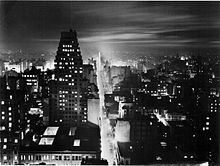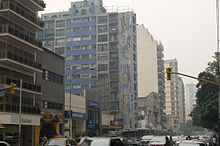- Avenida Corrientes
-
Location of Avenida Corrientes in Buenos Aires

Avenida Corrientes (English: Corrientes Avenue) is one of the principal thoroughfares of the Argentine capital of Buenos Aires. The street is intimately tied to the tango and the porteño sense of identity. Like the parallel avenues Santa Fe, Córdoba, and San Juan, it takes its name from one of the Provinces of Argentina.
It extends 69 blocks from Eduardo Madero Avenue in the eastern Puerto Madero neighborhood to the West and later to the Northwest, and ends at Federico Lacroze Avenue in the Chacarita neighborhood. Automobile traffic runs from west to east. Line B of the Buenos Aires Metro runs most of its length underneath the street.
The Asociación Amigos de la Calle Corrientes ("Friends of Corrientes Street Association") is a group that collaborates on the urban planning of the street. They have placed commemorative plaques on 40 street corners bearing the distinguished figures from the history of the tango.
Contents
History
 Intersection with Avenida 9 de Julio
Intersection with Avenida 9 de Julio
It was named del Sol during the 17th century, San Nicolás from 1738 to 1808, and de Incháurregui from 1808 until 1822, when it received its current name. Never more than a street of average width during the nineteenth century, traffic swelled after the city began its rapid westward expansion, around 1880. Horse-drawn tramways first ran on the avenue in 1887; but, they soon proved inadequate and in 1910, Mayor Joaquín de Anchorena signed a bill authorizing its widening.
The plan called for the massive razing of most of the avenue's north-side real estate and, so, met with strenuous opposition from affected landlords, retailers, as well as intellectuals like Roberto Arlt. A coup d'ètat in 1930, however, made way for the plan's implementation, carried out relentlessly until its completion, in 1936. The newly inaugurated avenue coincided with the construction of the Buenos Aires Obelisk, since then one of the city's most recognizable landmarks. Today, when referring to Corrientes prior to the widening, the term "Narrow Corrientes" (Corrientes Angosta) is used.
The opening of the Obelisk and surrounding Plaza de la República in 1936 created a roundabout at the Ninth of July intersection. Corrientes, like most major city avenues, was made a one-way thoroughfare by a 1967 municipal ordinance. Growing traffic demands led to the opening of the avenue through the plaza, and around the Obelisk, in 1971. Sidewalks were widened in 2005 to facilitate retail activity along the avenue, which had declined since the 1970s.[1] The section west of downtown between Avenida Callao and Uruguay Street is converted into an expansive outdoor reading room during Bookstore Night, an annual event inaugurated in 2007.[2] Mayor Mauricio Macri announced in 2010 that the financial district section of Corrientes, between Ninth of July and Avenida Leandro N. Alem, would become a two-way avenue.[3]
Points of interest
Base to obelisk
- Luna Park, former boxing ring, currently used for other sports
- The back of the Buenos Aires Central Post Office
- The downtown microcentro banking district
- Pedestrian Florida Street
- Teatro Gran Rex
- Teatro Opera
- Many of the country's most important theater companies.
- Numerous traditional and historical restaurants, including Argentine cuisine, Spanish cuisine and Italian cuisine.
- The Obelisk of Buenos Aires, at the intersection with 9 de Julio Avenue and the Plaza de la República.
“The street that never sleeps”
- Los Inmortales pizzeria, previously the Café de los inmortales, ("Café of the immortals") with photos of the historic figures that visited it.
- Güerrín pizzeria
- Café La Paz, historic meeting place for leftist activists
- Bar Ramos
- La Giralda Cafeteria, serving Spanish-style hot chocolate and churros
- General San Martín Theater
- Paseo La Plaza, an urban oasis with theaters, retail stores and restaurants
- Hernández, Liberarte, and many other bookstores
Off-Corrientes
"Off-Corrientes" refers to the alternative playhouse area. It is also home to the Ricardo Rojas Center of the University of Buenos Aires, which promotes experimental art (but is itself located on Corrientes).
Once
The Balvanera borough (also known as Once) is a traditionally Jewish neighborhood known for the wholesale and retail sale of clothing, now also home to merchants of other nationalities, including Koreans and Peruvians.
Abasto
Beyond Pueyrredón Avenue is the hometown of Carlos Gardel, the tango singer known as the "morocho ("dark-haired man") of Abasto". In disrepair not many years ago, the neighborhood is slowly making a comeback. The neighborhood's name is derived from the Mercado de Abasto, a former fruit and vegetable market refurbished by local developer IRSA into what is today the city's largest shopping center.
Almagro
Almagro is a calm residential neighborhood inhabited by apartment-dwellers. The center of activity is at the intersection of Medrano and Rivadavia Avenues.
Villa Crespo
Villa Crespo is another traditionally Jewish neighborhood. Unleavened bread is available for passover, as are other seasonal specialties. It is in this area (formerly called "Triumvirate") that the greater part of the 1948 Leopoldo Marechal novel, Adán Buenosayres, takes place; Marechal also wrote Historia de la Calle Corrientes in 1937. The neighborhood is home to the Atlanta football club.
The barrio was home to tango great Osvaldo Pugliese.
Chacarita
Corrientes ends at the Estación Federico Lacroze train station next to Parque Los Andes, where fairs where held until September 2005. Just west of the park is La Chacarita Cemetery; the largest in Argentina, the cemetery is at times referred to colloquially and in tango lyrics as La Quinta del Ñato (a lunfardo term referring to a person's last dwelling).
Avenida Corrientes The Broadway Theatre. Corrientes Avenue has long been Buenos Aires' Broadway
 Abasto shopping center. The city's wholesale market until 1984, investor George Soros had it converted in 1998.
Abasto shopping center. The city's wholesale market until 1984, investor George Soros had it converted in 1998.
Corrientes in tango music
Corrientes Avenue is featured in several tango lyrics, notably:
- A media luz by Carlos Lenzi and Edgardo Donatto
- Calle Corrientes by Alberto Vaccarezza and Enrique Delfino
- Corrientes angosta by Ángel "Pocho" Gatti
- Corrientes y Esmeralda by Celedonio Flores and Francisco Pracánico
- Tristezas de la calle Corrientes by Homero Expósito and Domingo Federico, 1942
- Pucherito de gallina
- Café Dominguez
References
- ^ "La avenida Corrientes pierde un carril". La Nación. http://www.lanacion.com.ar/676509-la-avenida-corrientes-pierde-un-carril.
- ^ "La avenida Corrientes, un gran escenario literario". Clarín. http://edant.clarin.com/diario/2007/03/30/laciudad/h-04201.htm.
- ^ "Avenida de Mayo y Corrientes serán doble mano antes de fin de año". Infobae. http://www.infobae.com/notas/509779-Avenida-de-Mayo-y-Corrientes-seran-doble-mano-antes-de-fin-de-ano.html.
External links
-
Streets of Buenos Aires, Argentina Buenos Aires Avenida 9 de Julio • Avenida Alvear • Avenida de Mayo • Avenida del Libertador • Avenida Callao • Caminito • Avenida Córdoba • Avenida Coronel Díaz • Avenida Corrientes • Avenida Figueroa Alcorta • Florida Street • Avenida General Paz • Avenida Leandro N. Alem • Avenida Roque Sáenz Peña • Avenida Rivadavia • Avenida Santa Fe • Avenida Scalabrini OrtizLandmarks of Buenos Aires Note: "Buenos Aires" denotes the city of Buenos Aires proper, not the entire Greater Buenos Aires metropolitan area. Public
& historic buildings
and structuresArgentine Congress · Torre Monumental · Cabildo · Café Tortoni · Casa Rosada · Central Post Office · City Hall · City Legislature · Customs House · Duhau Palace · Estrugamou Building · Floralis Genérica · Galerías Pacífico · Hotel de Inmigrantes · Kavanagh building · Libertador Building · Metropolitan Cathedral · Monument to Giuseppe Garibaldi · Obelisk of Buenos Aires · Palacio Barolo · May Pyramid · Pizzurno Palace · Plaza Hotel · Recoleta Cemetery · San Martín Palace · Sarmiento Frigate · Uruguay Corvette · The Water Company Palace · Women's BridgePrecincts
& neighbourhoodsAlmagro · Belgrano · Buenos Aires CBD · Caballito · City Centre · Colegiales · Montserrat · Núñez · Palermo · Puerto Madero · Recoleta · Retiro · San TelmoNature and parks Avellaneda Park · Botanical gardens · Buenos Aires Ecological Reserve · Chacabuco Park · Congressional Plaza · Japanese Gardens · Lezama Park · Palermo gardens · Plaza de la República · Plaza de Mayo · Plaza San Martín · Parque Centenario · Buenos Aires ZooCultural
InstitutionsEl Ateneo Bookstore · Argentine Automobile Club · Bernardino Rivadavia Natural Sciences Museum · Buenos Aires Museum of Modern Art · Café Tortoni · Fortabat Art Collection · House of Culture · Illuminated Block · Isaac Fernández Blanco Museum · King Fahd Cultural Center · Latin American Art Museum · Museum of Foreign Debt · National Library · National Museum of Decorative Arts · National Museum of Fine Arts · National Museum of History · Opera House · Paz Palace · Planetarium · Recoleta Cultural Center · San Martín Cultural Center · San Martín National Institute · Sarmiento Museum · Eduardo Sívori MuseumSport Bombonera Stadium · River Plate Stadium · Ducó Stadium · Maradona Stadium · Vélez Sársfield Stadium · Argentine Hippodrome of Palermo · Lawn Tennis Club · Polo Stadium · Race Circuit · Arena Obras Sanitarias · CeNARD · Estadio Ricardo EtcheverryTransportation Shopping
& entertainmentAbasto Mall · Avenida Theatre · Cervantes Theatre · Fishermen's Pier · Galerías Pacífico · Gran Rex Theatre · Luna Park Arena · Paseo La Plaza · Patio Bullrich · Opera Theatre · Parque de la Ciudad · La Trastienda ClubStreets
& avenues9 de Julio Avenue · Avenida Alvear · Avenida de Mayo · Avenida del Libertador · Callao Avenue · Caminito · Córdoba Avenue · Coronel Díaz Street · Corrientes Avenue · Figueroa Alcorta Avenue · Florida Street · General Paz Avenue · Leandro Alem Avenue · President Roque Sáenz Peña Avenue · Rivadavia Avenue · Santa Fe Avenue · Scalabrini Ortiz AvenueCoordinates: 34°36′14″S 58°23′10″W / 34.603978°S 58.386201°W
Categories:- Streets in Buenos Aires
Wikimedia Foundation. 2010.








